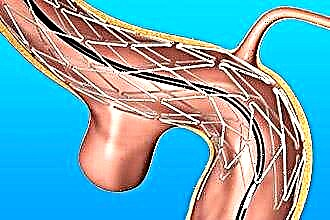There are many types of rhinitis, which differ in causes, mechanisms of development and clinical symptoms. The most effective therapeutic measures are selected depending on the form of rhinitis. Hyperplastic rhinitis is a chronic form. At the heart of its development is hyperplasia, as a result of which the mucous membrane of the nasal cavities thickens.
 Only a doctor can diagnose pathology based on the results of the examination. Symptomatically, this form of rhinitis practically does not differ from other types.
Only a doctor can diagnose pathology based on the results of the examination. Symptomatically, this form of rhinitis practically does not differ from other types.
A disease such as a hyperplastic rhinitis, in most cases, is diagnosed in people with a deformed septum or anomalies in the structure of the nasopharynx. The proliferation and hardening of connective tissue leads to a narrowing of the lumen of the nasal passages and difficulty breathing.
On examination, the doctor visualizes a small seal in the area of the nasal passages of a maroon color. To confirm the diagnosis, a test with an adrenaline solution is performed, during which the degree of growth changes after drug administration is assessed.
Vasoconstrictor nasal drops are not able to restore nasal breathing with hyperplasia of the nasal mucosa.
Main reasons
As an independent disease, hyperplastic rhinitis occurs extremely rarely. Often, its development is preceded by a prolonged inflammatory process in the nasal mucosa. Among the weighty reasons should be highlighted:
- unfavorable environmental conditions of the area where the person lives. For example, an industrial zone, an area of large highways;
- occupational hazards associated with air pollution with fine dust particles, chemicals, strong odors;
- frequent hypothermia, including at work;
- allergic predisposition;
- chronic infectious diseases of the nasopharynx and throat (sinusitis, pharyngitis);
- adenoids;
- smoking;
- diseases of the nervous system.
As the disease progresses, the thickness of the nasal mucosa increases, the surrounding tissues feel pressure, due to which microcirculation is impaired. As a result, the delivery of oxygen and nutrients is reduced, and the tissues experience hypoxia. In addition, local protection decreases, which predisposes to infection and activation of opportunistic flora.
These processes support chronic inflammation in the nasopharynx, further increasing tissue hyperplasia.
Symptomatically, the disease manifests itself with mild symptoms, however, with an exacerbation, a typical picture of rhinitis is observed. A provoking factor that leads to an exacerbation of the disease can be:
- prolonged exposure to cold, inhalation of cold air;
- untreated acute throat diseases of infectious genesis (tonsillitis);
- long-term use of nasal aerosols with vasoconstrictor properties.
How is the pathology manifested?
During periods of remission and exacerbation, hyperplastic rhinitis manifests itself with the same symptoms, which differ only in varying degrees of severity. The clinical signs of the disease include:
- discharge from the nose of a viscous consistency, with an admixture of purulent masses, which is visually manifested by a yellow-green tint of mucus;
- Difficulty nasal breathing - due to narrowing of the lumen of the nasal passages;
- change in the timbre of the voice, nasal tone;
- deterioration of auditory function - due to partial overlap of the lumen of the auditory tube;
- pain in the bridge of the nose, frontal region;
- snore;
- dry mouth, as the person has to breathe through the mouth;
- feeling of a foreign element in the nose;
- poor sleep;
- decreased appetite;
- oppression of the sense of smell up to anosmia.
Self-treatment attempts can lead to complications.  The severe consequences include nosebleeds and the complete absence of breathing through the nose. When the inflammatory process spreads to the auditory tube, hearing worsens. It is also possible the appearance of a headache, the development of bronchitis, adenoiditis, conjunctivitis.
The severe consequences include nosebleeds and the complete absence of breathing through the nose. When the inflammatory process spreads to the auditory tube, hearing worsens. It is also possible the appearance of a headache, the development of bronchitis, adenoiditis, conjunctivitis.
If hyperplastic rhinitis is diagnosed in childhood, the risk of delayed physical as well as psycho-emotional development increases.
Cold treatment
It takes a lot of effort to get rid of a cold. This applies to both drug therapy and lifestyle changes. A person needs to quit smoking, change working conditions or even place of residence. The main task of treatment is to eliminate the provoking factor.
In the early stages of the disease, conservative treatment is carried out, which includes:
- glucocorticosteroids in nasal form, for example, Avamis, Nasonex;
- injections of hormonal drugs, glycerin, glucose;
- solution Protargol, Collargol.
In the absence of an effect from conservative methods, cauterization of growth zones with the help of acids (chromic, trichloroacetic) is prescribed. In addition, the following can be applied:
- cryo, laser therapy;
- ultrasonic exposure;
- galvanocaustics;
- intra-shell mechanical action.
 The listed manipulations require local anesthesia. The purpose of the intervention is to eliminate pathogenic pathogens, glue the submucosal layer and reduce the volume of growths.
The listed manipulations require local anesthesia. The purpose of the intervention is to eliminate pathogenic pathogens, glue the submucosal layer and reduce the volume of growths.
Surgical treatment (conchotomy) involves the treatment of areas of hyperplasia with scissors or a loop. The operation can be partial, radical, or submucosal. Rarely enough in the postoperative period, nosebleeds are observed.
Note that conservative and surgical treatment is considered palliative, that is, it cannot completely rid a person of a hyperplastic rhinitis. Recovery is possible if the negative factor is eliminated at the initial stage of the disease.
An unconventional treatment approach
It is impossible to cure hyperplastic rhinitis with the help of folk remedies, therefore they are used exclusively as an auxiliary method of therapy. Having agreed with the otolaryngologist, you can use the following means:
- two grams of St. John's wort, sage should be mixed, pour 230 ml boiling water and leave to infuse for two hours. After filtration, you can use the infusion for washing twice a day;
- 3 g of salt, soda must be mixed, dissolved in warm water with a volume of 270 ml and a couple of drops of iodine added. The solution is used for washing once a day;
- mix 50 ml of warm water and celandine juice, drip five drops into the nose twice a day;
- 15 g of chamomile should be poured with boiling water (220 ml), left to infuse for 40 minutes, filtered and used for washing twice a day;
- undiluted thuja oil is recommended for use in an aroma lamp. Once diluted, the oil can be used to rinse or instill the nose. It is used to boost immune defenses and reduce inflammation.
Herbal preparations can cause an allergic reaction.
To determine the presence of allergies, it is enough to drop the drug on the dorsum of the wrist and evaluate the result after half an hour. If redness, itching, rash or peeling occurs, the drug should be discarded. Note that it is forbidden to wet and comb the area of the skin with the applied medicine during the day.
Preventive recommendations
The main methods of prevention are aimed at preventing the transition of the catarrhal form of rhinitis to hyperplastic. If hyperplasia does appear, it is necessary to engage in prevention to prevent the progression of the pathological process.
The first step is to sanitize chronic infectious foci of the throat and nasopharynx (tonsillitis, sinusitis). For this, the otolaryngologist prescribes treatment and assesses the dynamics using laboratory and instrumental methods.
With frequent allergies, especially hay fever, preventive therapy should be started two weeks before the flowering period. It will allow you to prevent the appearance of severe symptoms, even with the development of allergies.
In addition, you should stop smoking, engage in tempering and pay attention to working conditions. Do not neglect a visit to the doctor if you are worried about frequent colds and nasal congestion. Only timely diagnosis and treatment will avoid complications.



